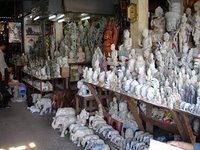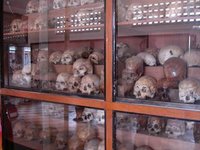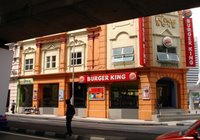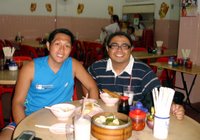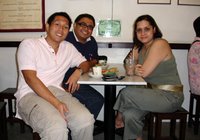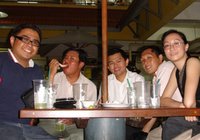
Weather forecast today: Mixed clouds and sun with scattered thunderstorms. High 88F. Winds ESE at 5 to 10 mph. Chance of rain 60%. I woke up this morning at 5:30 a.m. and was ready to leave at 6 a.m. since the motorcycle was picking me up at that time, only to find out that it was drizzling. And it seemed this was the type that won't stop.
I checked the weather forecast since I was thinking of postponing it to the next day. It was going to rain as well. And it's supposed to be the dry season. I think it's some sort of blessing from heaven since the Khmer New Year is in a few days. If it didn't stop raining at 8 a.m. I told myself, I'd take the risk and check out the sites nevertheless. Anyway, I had breakfast at a popular tourist restaurant. I ordered a beef sandwich. Unlike the Philippines where our sandwich bread is usually tasty bread, in Cambodia, as well as in Vietnam, they use baguettes, since they were former French colonies. Expect a one-foot sandwich to arrive. I paid US$2 for it but I'm sure you could get it cheaper at less popular places. It was great!
 The gamble I made paid off! Even though it was drizzling, it wasn't that much a bother. But because it was drizzling, Angkor Wat was quite empty. No droves of tourists! But seriously, I am amazed with the number of people the temples of Angkor are able to attract. I mean there were busloads of them speaking in different tongues. Listen up DOT, this UNESCO World Heritage Site attracts more people than the entire island of Boracay. And each pays US$20 for a one-day pass, US$40 for a three-day pass or US$60 for a one-week pass! So I suggest we start focusing on inbound cultural experiences as well as heritage tours and not just Boracay. Foreigners know Boracay already and thus, there in no need to promote it. You should find new destinations and work on them instead. Maybe even help have some more UNESCO sites declared in the Philippines.
The gamble I made paid off! Even though it was drizzling, it wasn't that much a bother. But because it was drizzling, Angkor Wat was quite empty. No droves of tourists! But seriously, I am amazed with the number of people the temples of Angkor are able to attract. I mean there were busloads of them speaking in different tongues. Listen up DOT, this UNESCO World Heritage Site attracts more people than the entire island of Boracay. And each pays US$20 for a one-day pass, US$40 for a three-day pass or US$60 for a one-week pass! So I suggest we start focusing on inbound cultural experiences as well as heritage tours and not just Boracay. Foreigners know Boracay already and thus, there in no need to promote it. You should find new destinations and work on them instead. Maybe even help have some more UNESCO sites declared in the Philippines.  Anyway, Angkor Wat was breathtaking. It's definitely a must visit for any trip to the temples of Angkor. Constructed by Suryavarman II in the mid-12th century, the apex of Khmer military and political dominance in the region, it was dedicated to the Hindu god Vishnu. But today, images of Buddha can be found.
Anyway, Angkor Wat was breathtaking. It's definitely a must visit for any trip to the temples of Angkor. Constructed by Suryavarman II in the mid-12th century, the apex of Khmer military and political dominance in the region, it was dedicated to the Hindu god Vishnu. But today, images of Buddha can be found. The walk across the moat was simply awe-inspiring. It was as if you were about to enter Heaven. And the chants from Buddhist monks really set the mood. The massive three-tiered pyramid crowned by five beehive-like towers rising 65 meters makes you wonder how on earth that generation of citizens of the world were able to construct these monuments when today, new monumental structures are a rarity.
We then entered the Angkor Thom South Gate. Welcoming you was a row of soldiers and a large monument of Jayavarman VII. Angkor Thom is a 3 square kilometer walled and moated city and the last capital of the Angkorian empire. Inside Angkor Thom, I visited Bayon (below), the other must visit temple of Angkor. It is most known for the 37 towers with carved faces oriented towards the cardinal points. A topic of debate, many say the faces are a composite of Jayavarman VII and Buddha.
 Also inside the Angkor Thom are the Baphuon, Phimeanakas, Terrace of the Elephants and Terrace of the Leper King among many other structures.
Also inside the Angkor Thom are the Baphuon, Phimeanakas, Terrace of the Elephants and Terrace of the Leper King among many other structures.  We exited the Victory Gate (left) and stopped over at Thommanom, a small but attractive temple built at the same time as Angkor Wat. A few meters away was the Ta Keo. Down the road was Ta Prohm (below), another Jayavarman VII built temple which saw the limelight as Lara Croft's Tomb Raider temple. The thing I liked about my visits to the different sites was there was traditional Khmer music meeting us all the time. Just like our blind rondallas in the Philippines, the musicians were victims of landmines playing on traditional Khmer instruments.
We exited the Victory Gate (left) and stopped over at Thommanom, a small but attractive temple built at the same time as Angkor Wat. A few meters away was the Ta Keo. Down the road was Ta Prohm (below), another Jayavarman VII built temple which saw the limelight as Lara Croft's Tomb Raider temple. The thing I liked about my visits to the different sites was there was traditional Khmer music meeting us all the time. Just like our blind rondallas in the Philippines, the musicians were victims of landmines playing on traditional Khmer instruments.  I had an early lunch in front of Ta Prohm. I had another sandwich, this time pork. But since we were in a heavy-traffic tourist area, expect costs to go up. It was US$2.50 and US$1 for a 500ml bottle of water. Imagine the profit they make charging at US prices with their costs much lower. See what tourism can do. And to think the big serving of rice toppings I ate yesterday night and tonight at this new restaurant in front of CCB Bank Siem Reap, Sivutha Street, is just US$1 each!
I had an early lunch in front of Ta Prohm. I had another sandwich, this time pork. But since we were in a heavy-traffic tourist area, expect costs to go up. It was US$2.50 and US$1 for a 500ml bottle of water. Imagine the profit they make charging at US prices with their costs much lower. See what tourism can do. And to think the big serving of rice toppings I ate yesterday night and tonight at this new restaurant in front of CCB Bank Siem Reap, Sivutha Street, is just US$1 each!  Further down the road was Pre Rup (below right), another Hindu temple which is architecturally and artistically superior. Next was East Mebon, a Hindu temple dedicated to Shiva. Ta Som was a few kilometers away. It is the most distant temple on the grand circuit, they have two set routes around Angkor, the small tour and the grand tour which tourists can pick from depending on time.
Further down the road was Pre Rup (below right), another Hindu temple which is architecturally and artistically superior. Next was East Mebon, a Hindu temple dedicated to Shiva. Ta Som was a few kilometers away. It is the most distant temple on the grand circuit, they have two set routes around Angkor, the small tour and the grand tour which tourists can pick from depending on time.  Ta Som (below left) is currently being restored with the help of the World Monuments Fund. Imagine hundreds and thousands of dollars pouring in Cambodia to help restore these temples.
Ta Som (below left) is currently being restored with the help of the World Monuments Fund. Imagine hundreds and thousands of dollars pouring in Cambodia to help restore these temples. I also noticed each site had a counterpart donor like Japan, China, France and India, who helped fund the restoration of the sites. I wonder why the Philippines does not ask for Japanese funding to rebuild Inramuros since the treasures were flattened as a result of the Second World War anyway.
 The US should fund also since it was their carpet bombing that flattened most of Manila. Spain should help also since they benefited from this former colony, once the Pearl of the Orient, for over three centuries! But I guess government is too busy with their own useless squabbles to even think of preserving heritage.
The US should fund also since it was their carpet bombing that flattened most of Manila. Spain should help also since they benefited from this former colony, once the Pearl of the Orient, for over three centuries! But I guess government is too busy with their own useless squabbles to even think of preserving heritage. The last two major sites on the grand ciruit were the Neak Pean, a small island temple, and the Preah Khan (below), a really huge monastic complex which was highly-explorable thanks to the many carvings and passage ways. We went back in Angkor Thom via the North Gate. Then it was off to Siem Reap town.
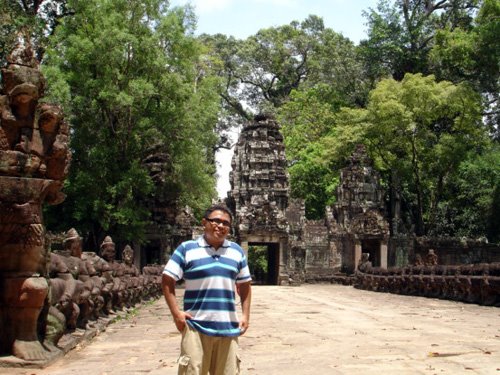 It's great seeing so much heritage. But a sad note was the headless statues all over the place. Looters really made a lot of money from Angkor. Oh these collectors!
It's great seeing so much heritage. But a sad note was the headless statues all over the place. Looters really made a lot of money from Angkor. Oh these collectors! Anyway, it looks like I will have a lot of time to relax. My bus to Bangkok leaves at 7 a.m. on Monday so I'll be free the whole day tomorrow.

